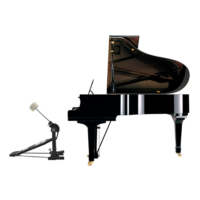Interpretation is often thought of as the auditory output of a performance, but every performance is influenced by visual cues (Tsay 2013). The musician, who is typically the most dominant visual representation on stage, embodies a manifestation of the music, shaping our expectations and perception through behavior, movements, and attire.
In the classical tradition, musicians often project their professional persona onto the role, presenting themselves authentically. Yet, they share similarities with actors. Like actors, musician’s express emotions and embody the music through physical gestures, becoming emotionally, intellectually, and physically immersed in their performance.
However, the role of the musician is often understated, perhaps due to the focus on the music itself. Adopting a more active strategy towards the musician’s identity opens up a plethora of possibilities. This could involve internal adjustments, building on the audience’s perception of the authentic musician, or external role-playing through clothing, behavior, and movements.
Small changes, such as attire or attitudes, can significantly alter the perception of the music. For example, a musician dressed as a homeless or musicians rolling up their sleeves before playing will undoubtedly transform the experience of the music for the audience.
Moreover, these possibilities extend to the interpretation itself. Musicians can extend the interpretation by constructing a persona as a part of the interpretation, including how this person would dress, walk, and move, encapsulating the interpretation from entrance to applause.
Finally, as masks aid actors, adopting a new persona as a musician can empower and liberate the performer, allowing for greater artistic expression on stage.
In the following example of a staged concert developed with Marion Reuter from The Danish National School of Performing Arts, we explore how different personas can contribute to the interpretation of the works being performed.
The program was as follows:
Liese-Lotte Bekaert playing Sarhan's Homework
Charlotte Norholt and Henrik Knarborg playing Takemitsu's Towards the Sea
Zsófi Kamilla Persányi playing Schoenberg's Op. 11
Charlotte Norholt, Henrik Knarborg, and Søren Rastogi playing Kondo's Standing
Søren Rastogi playing Beethoven's Waldstein (1st movement)
Henrik Knarborg playing Xenakis' Psappha
The development of the final concert, which included not only the creation of personas but also an overall narrative and staging, can be summed up in the following three steps:
- Identifying a persona for each musician: The persona did not need to be explicitly recognized by the audience but provided each musician with an internal license for their interpretation, allowing the persona to be the “cause” of the interpretation.
- Deciding on a narrative: In this case, the following background story was invented. A group of talented but not very well-adjusted musicians is, through misunderstandings, hired to be in charge of activities for guests on an all-inclusive vacation, such as a children’s show, a yoga session, and a late-night concert. This narrative was not explained to the audience but used to create reasons for the interpretations.
- Staging of the concert: The concert was staged as a series of sessions or stations, one of which included an arrangement of sofas where the musicians hung out when they were not performing.
The following are excerpts showing the transition between each work.
Signe Madsen and Søren Rastogi’s interpretation of Saariaho’s Tocar
Another example of incorporating a persona into an interpretation is Signe Madsen and Søren Rastogi’s version of Saariaho’s “Tocar” for violin and piano. This interpretation was inspired by two observations about the music:
First, the violin part is rather dissonant, while the piano features longer passages of more harmonious material. Second, the title “Tocar,” meaning “to touch,” is described by Saariaho as follows: “In ‘Tocar’ both instruments move forward independently but also keep an eye on each other. I imagine a magnetism becoming stronger and stronger – the piano part becomes more mobile – which draws the violin texture towards the piano writing, culminating in an encounter in unison.”
Based on these observations, two personas were added to amplify the existing qualities: a concert pianist, who believes he is performing a beautiful and emotionally charged solo piano piece, and a violinist, who hides behind the pianist, secretly commenting with dissonant intervals and aggressive musical energy.
At the beginning, the interruptions are met with resistance and irritation from the pianist, but as the piece progresses, this changes to acceptance.
So initially, there are long pauses between the musical statements, allowing the pianist time to react to the violinist’s “ugly” interjections while attempting to return to his initial, more harmonious starting point. But this fragmented and contrasting interplay ultimately evolves into a unified musical direction by the end of the piece.
· see also ·
